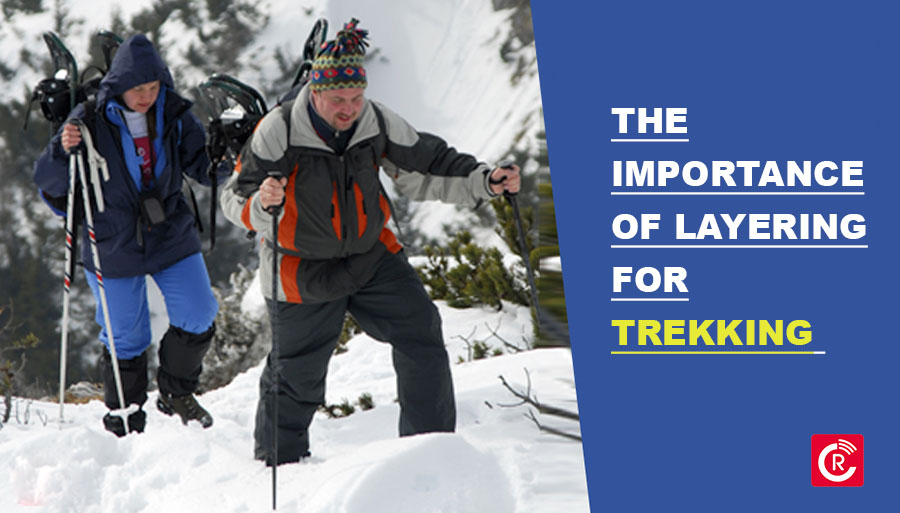
Layering is an important concept to have in your knowledge. Three main layers are vital, with each one with a specific purpose.
Layering is a simple strategy based on putting one layer on top of the other to stay warm during treks. Sounds simple, right? But there’s a lot of misconceptions about it.
Read step by step what it is and how it works.
The Concept Of Layering
Air is one of the best insulators. When we wear two t-shirts; It captures a layer of air in between. And it retains our body that works as a key insulation layer that generates heat within. It is used to keep yourself warm with minimum and lightweight clothing while going for any outdoor activity in a colder environment like trekking.
How does it work?
- If the human body is in a place with less temperature than the body temperature, it generates heat.
- The clothes layer retains the body heat more effectively as an invisible insulation layer of air pads every two layers of cloth in between.
- Clothes do not generate heat; they protect you from getting cold or weather. And it retains the body-generated heat within it.
- So, more layers of clothes, more insulation layers of air, and warmer.
Our body generates heat in a cold environment; we keep warm by generating body heat and clothing. The sleeping bags people use on treks are built using the concept of layering to keep them warm.
Remember, clothes do not generate heat; it’s the retention of heat generated by our body, which keeps us warm.
However, the heat-generating capability is usually similar for the similarly aged group. As we get older, the heat-generating capability decreases.
The layers we use can be divided into three categories – The Base Layer, Mid Layers, and finally, The Outer One.
Base Layers:
The base layer lies right next to your skin. It is meant to absorb moisture. This layer should never be Cotton, as Cotton will hold moisture on your body and keep you cold.
Base layers should be light enough to wear for indoor activities but not warm enough to be worn alone outdoors in the cold weather.
The base layer should be lightweight and of synthetic material or natural fabric. A base layer should fit against the skin but not so tight to restrict movement.
- During any activity, our body sweats. So wear something that catches sweat.
- In cold weather, the base layer should hold some insulating properties. Also, it should be comfortable and warm with close-fitting.
- Different people are allergic to different materials of fabric, and it causes itching. So, choose the right material for your skin. Removal of a base layer during activity is the most painful task to perform.
- Bad odor is the major problem with sweat and leads to bacterial infection. A good base layer should tackle it smartly too.
- It’s good to keep an extra-base layer, especially for those people who sweat more often.
Mid Layer:
Mid-layer goes on top of the base one. Think of the mid-layer as your insulation from the cold. This layer is likely to trap air and keep you warm, so the fitting should be close to the body but not too much. That could be a lightweight one or a 600 fill down jacket, depending on the weather and temperature.
Also, pack an extra coat in your pack as a backup mid-layer for your trip. A down vest is a great choice as a mid-layer to keep your body warm while allowing your full arms mobility. If the weather isn’t wet, some mid-layers will serve as an outer layer.
- Wearing a mid-layer as an outer layer while ski will prevent your outer layer from getting condensation from sweat. You’ll be dryer and warmer and on the way down.
- The mid-layer should not be tight on the base layer.
- Your base layer can consist of multiple layers of clothes based on temperature conditions. More layers can create a more insulating air between and feels warmer.
- Avoid more than 2-3 clothes.
- Go for a warmer layer.
- In trekking, your lower body will always be warmer than your upper. But you can use synthetic track pants for extra warmth at a campsite when the body is at rest.
Outer Layer:
This layer is your protection from the cold weather. Wear an outerwear layer that is waterproof, breathable, and windproof. It isn’t easy to find an Outer Layer that will fit all of these three requirements for every sport you do. GORE-TEX fabric is a great option for people looking to meet all three elements in one jacket.
- Try layers that work for you during your outdoor activities.
- Let’s sweat vapor escape to protect you from the cold temperature, so you don’t get wet from sweat inside your layering system. It’s your shell for a trek.
- This layer should be easy to wear and remove. As with changing the temperature, you will perform that often.
- If you experience rain and wind in good quantity, you don’t have an outer shell to catch-all. In that case, you need to wear many. For heavy rain cases, waterproof rain is cut at the top of the wind shell.
- The outerwear should fit comfortably over the other layers without limiting your movement.
- Other properties like waterproof should be in order according to the condition. Though with these two proofing qualities, cheaper fabric loses its breathability to a good extent.
Is Cotton a good layer for trekking?
Cotton is for everyday use but not for trekking. Cotton traps moisture, whether from nature or sweat, from your body.
When Cotton gets wet, it doesn’t dry out easily. It cools your body temperature and makes a huge temperature rise while walking. If it’s windy, Cotton can make you seriously cold.
So, Cotton is not for trekking; remember that.
Thick Layers Vs. Thin Layers
When we talk about being warm, there’s a thought of wearing as many layers as possible. You have to remember that you’re going to be moving and generating heat. Thin layers are better than thick layers while trekking for several reasons.
Thin layers are more versatile. On treks like Everest Base Camp or Kilimanjaro, it’s not freezing for the entire trek. If you bring many big thick layers, you won’t use them for most of the trek. Also, thick layers can cause you problems with weight and space when packing.
Thick layers while hiking is awkward to wear. However, you might not be able to see your feet and move easily.
Wearing a thick layer often makes people overheat, but they won’t take off a big layer as they get too cold without a layer. By wearing thinner layers, you can regulate your body temperature more efficiently.
Thin layers are the best option to choose. They provide more versatility through different temperature areas. Below the mountain, it can be pretty warm, so going for thinner layers gives you more control in layers you can wear as you trek.
Each layer must marry well with the next one as you choose the various layers. Then you end up with a layering that can adapt to different temperatures.
So which materials are best for trekking in cold weather?
Wool: It is an excellent insulator. It even holds its abilities as an insulator if it gets wet. One con is that it is somewhat heavy. Too much wool will make your pack heavy.
Synthetic: You can compare the ability of synthetics to insulate to wool. They are made to be comfortable and feel soft against your skin. The fibers do not absorb or hold moisture and wick it away from the body. The material is tightly twisted together and can help keep the wind out if coated; it even protects from rain and snow.
Down Feather: This material ranks as one of the best options. It will keep you warm when everything else loses.
Cold-weather layers:
- Moderate polyester underwear top/bottom
- Midweight fleece pants
- A jacket with synthetic insulation
- Waterproof rain jacket and pants.
Rainy-weather layers:
- Lightweight polyester underwear top and bottom
- Synthetic hiking pants
- Lightweight fleece jacket
- Lightweight waterproof and breathable raincoat, jacket, and pants.
Hot-weather layers:
- Polyester and a short-sleeve synthetic Tee
- Lightweight wind jacket.
- Convertible nylon hiking pants
You have dozens of alternatives and options for each of these layers literally. The trick is to go with choices that make the most understanding of where you’re headed.
It’s also important that you take the time to try and adjust layers as temperature conditions change. If the wind lets up, remove one layer. If trekking isn’t warming you up, add one.
Final Words:
When it comes to being comfortable in trekking, forget the fashionable layer. The layering method provides versatility to your attire and offers great experiences outside despite the weather.
Remember, Cotton is out, and synthetic fabrics are in.





